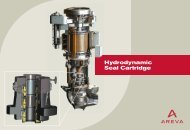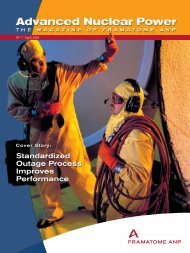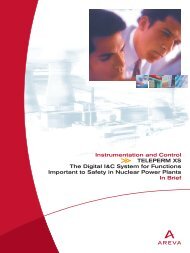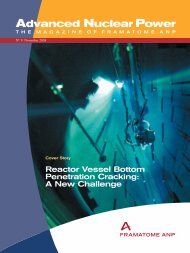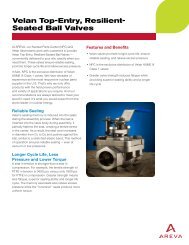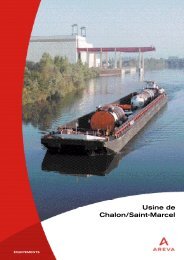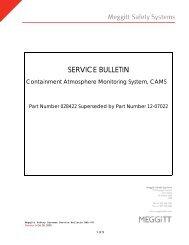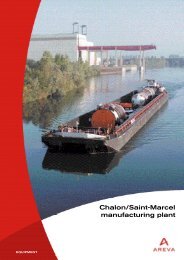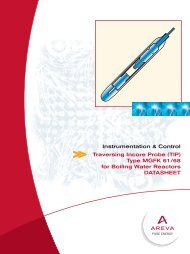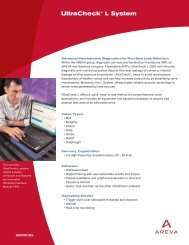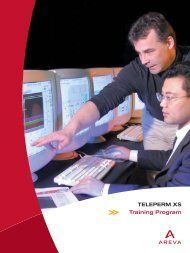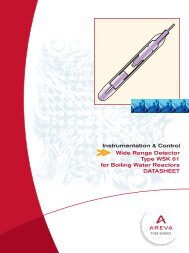EPR – Areva brochure
EPR – Areva brochure
EPR – Areva brochure
Create successful ePaper yourself
Turn your PDF publications into a flip-book with our unique Google optimized e-Paper software.
■ <strong>EPR</strong> NUCLEAR ISLANDIn-core instrumentationREACTOR CORE12 lance yokes,each comprising:<strong>–</strong> 3 T.C coreoutlet<strong>–</strong> 6 in-coredetectors<strong>–</strong> 3 or 4 aeroballprobes1 T.C upperplenum89 controlassemblies4 waterlevelCHARACTERISTICSDATAReactor coreThermal power4,500 MWthOperating pressure155 barNominal inlet temperature 295.6 °CNominal outlet temperature 328.2 °CEquivalent diameter3,767 mmActive fuel length4,200 mmNumber of fuel assemblies 241Number of fuel rods 63,865Average linear heat rate156.1 W/cm†Typical initial core loadingThe reactor core contains the fuel material in which the fissionreaction takes place, releasing energy. The reactor internalstructures serve to physically support this fissile material,control the fission reaction and channel the coolant.The core is cooled and moderated by light water at a pressure of155 bar and a temperature in the range of 300 °C. The coolantcontains soluble Boron as a neutron absorber. The Boronconcentration in the coolant is varied as required to control relativelyslow reactivity changes, including the effects of fuel burnup.Additional neutron absorbers (Gadolinium), in the form of burnableabsorber-bearing fuel rods, are used to adjust the initial reactivityand power distribution. Instrumentation is located inside and outsidethe core to monitor its nuclear and thermal-hydraulic performanceand to provide input for control functions.The <strong>EPR</strong> core consists of 241 fuel assemblies. For the first core,assemblies are split into four groups with different enrichments (twogroups with the highest enrichment, one of them with Gadolinium).For reload cores, the number and characteristics of the freshassemblies depend on the type of fuel management schemeselected, notably cycle length and type of loading patterns. Fuelcycle lengths up to 24 months, IN-OUT and OUT-IN fuelmanagement are possible. The <strong>EPR</strong> is designed for flexible operationwith UO 2 fuel and/or MOX fuel. The main features of the core and itsoperating conditions have been selected to obtain not only highthermal efficiency of the plant and low fuel cycle costs, but alsoextended flexibility for different fuel cycle lengths and a high level ofmaneuverability.Core instrumentationThe core power is measured using the ex-core instrumentation, alsoutilized to monitor the process to criticality.The reference instrumentation to monitor the power distribution inthe core is an “aeroball” system. Vanadium balls are periodicallyinserted in the core. Their activation level is measured, giving valuesof the local neutron flux to construct the three-dimensional powermap of the core.The fixed in-core instrumentation consists of neutron detectors andthermocouples to measure the neutron flux distribution in the coreand temperature distribution at the core outlet.The whole in-core instrumentation package is introduced from thetop of the reactor pressure vessel head. Therefore, the bottom ofthe reactor pressure vessel is free from any penetration.For additional information see the “Instrumentation and Controlsystems” chapter, page 42.Ex-coreAeroballT.CIn-coreT.C: ThermocoupleGGGGGGGG GHigh enrichmentwith GadoliniumHigh enrichmentwithout GadoliniumGGGGG GG GG GGGGGGGGGGGMedium enrichmentLow enrichmentThe core design analyses demonstrate the feasibility of differenttypes of fuel management schemes to meet the requirementsexpressed by the utility companies in terms of cycle length and fuelcycle economy (reload fraction, burnup), and to provide the corecharacteristics needed for sizing of the reactor systems. The nuclearanalyses establish physical locations for control rods, burnablepoison rods, and physical parameters such as fuel enrichments andBoron concentration in the coolant. The thermal-hydraulic analysesestablish coolant flow parameters to ensure that adequate heat istransferred from the fuel to the reactor coolant.Isar 2 unit, Germany (KONVOI, 1,300 MWe): fuel loading operation.† The <strong>EPR</strong> core is characterized byconsiderable margins for fuel managementoptimization.† Several types of fuel management (fuelcycle length, IN-OUT/OUT-IN) are availableto meet utilities’ requirements.† The main features of the core and itsoperating conditions give competitivefuel management cycle costs.† The <strong>EPR</strong> core also offers significantadvantages in favor of sustainabledevelopment:• 17% saving on Uranium consumptionper produced MWh,• 15% reduction on long-lived actinidesgeneration per MWh,• great flexibility for using MOX (mixedUO 2 -PuO 2 ) fuel assemblies in the core,i.e. of recycling the plutonium extractedfrom spent fuel assemblies.16 II 17



